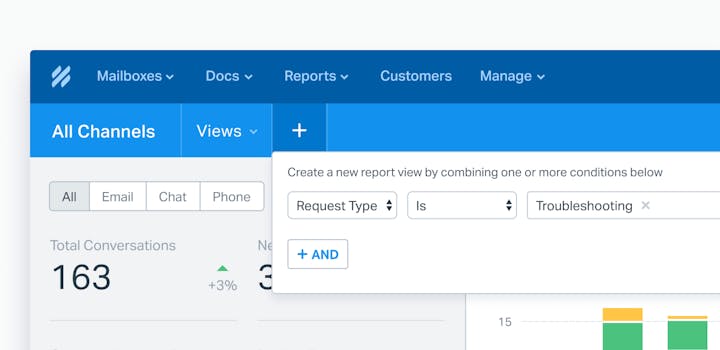The 6 Best Remote Collaboration Tools for Customer Service Teams


Because our Customers team at Help Scout is a remote team of 18 (and growing), we are very reliant on asynchronous communication to make collaboration effective, both within our team and with other teams.
With many companies making the shift to working from home, we thought we’d share our current collaboration tool set.
It’s an ever-evolving process of trial and error as we continue to refine it and find new services to fit our needs. However, these are the six remote collaboration tools that we've found most effective for our team at this point in time.
1. Slack
Slack is a major part of our workday because it’s a great way to promote and encourage asynchronous communication. We have multiple channels for cross-team communication — from our ontopic channel with company-wide announcements to t-ops where we can chat with our Ops team.
However, we also have several Cteam-related (Customers team) channels as well:
A private channel for just our Support team to chat about all things cteam-related — from getting a second set of eyes while working through conversations to letting teammates know when we’ve got to run to appointments.
A public channel, the sole purpose of which is to act as a wiki to post bugs we’ve logged, updates to saved replies, or important upcoming changes.
An off-topic channel where we can send GIFs, post links to funny tweets or videos, and chat about anything, really!
2. Jira
In the last year, we’ve moved from Trello to Jira to track all of our bugs, notes for improvements, and feature requests.
Parts of our Engineering team first moved to Jira the year prior, and once more teams started moving on there, it made sense for the Support team to as well, to make collaboration and tracking much easier.
Whenever we receive feature requests from customers or bug reports, we use the Help Scout/Jira integration to quickly search for the existing issue in Jira from Help Scout or to create a brand new one.
Our Product Specialists on our Customers team will then sift through and either add them to our backlog or escalate to the appropriate Engineering team based on whether it’s trending, the severity of the bug, the engineers’ capacity, etc.
3. Slab
We use Slab to house all of our company’s internal documentation. It has a great user experience and is easy to edit, read and organize.
For our team’s documentation, we keep all of our current internal processes, guidelines, and training docs contained within Slab. We also give editing rights to all teammates so that if anyone notices something is incorrect — or even comes across some helpful knowledge nuggets — they have the ability to edit the article.
Because our entire company has access to the documentation (just as we have access to other teams’ articles), it also gives people who aren’t on the Customers team the ability to quickly find the answers they need if they’re working through a conversation with a customer.
4. Zoom

The world is quickly becoming “Zoomed out” as many companies are using the platform to handle meetings; however, it’s definitely one of our favorites here at Help Scout! Zoom is a great tool for collaborating for meetings, and we use it for a variety of different situations.
Our weekly team huddles are always hosted in Zoom — primarily because we can record the meeting and it’s automatically emailed to the team. This makes it very helpful for teammates who were out or for folks in other time zones to watch at a later date (we also alternate meeting times each week to make it timezone-friendly for Europe and Australia).
We use Zoom for one-on-one meetings, fikas, and setting up audio calls or screen-shares with customers. Some of us also use Zoom as a way to quickly chat through difficult conversations with each other when Slack just doesn’t do the trick! It’s a nice way to talk through something and get others’ perspectives and to also get some face time with teammates.
Lately, some teammates have set up “Fika Cafes” where you can hop on Zoom, set your background as your favorite cafe (or anything really!), and work alongside in silence as if you were working from a coffee shop with them. It’s been a big hit!
5. Google Calendar

Google Calendar lets us keep track of several different events: who is out of the office for the upcoming week, birthdays/anniversaries, team meetings, live chat shifts, and when our classes are happening.
It helps us to see what’s going on for the week ahead and to plan accordingly in terms of moving around chat shifts or keeping tabs of which public holidays are coming up (since that can vary greatly based on the country).
Since Google Calendar is so easy to use and edit (and since we use G Suite here at Help Scout), it’s been one of our longest-used services.
6. Help Scout
Surprise! We use Help Scout for all of our customer support needs. 😄 Several features in particular really help us stay on track as a remote support team.
Try the customer support platform your team and customers will love
Teams using Help Scout are set up in minutes, twice as productive, and save up to 80% in annual support costs. Start a free trial to see what it can do for you.
Try for free
@mentions
The ability to mention one another in notes is useful for getting others to chime in with their expertise and input, as well as for keeping a "paper trail” of communication in our account.
It’s an asynchronous-friendly and non-invasive way to get someone’s help without actually having to assign a conversation or wait for a pingback on Slack or via email.

Following conversations
Being able to follow conversations is particularly helpful for new teammates going through onboarding: They’re able to receive notifications for each reply and keep a record for learning purposes.
The “follow” feature also comes in handy when we’re signing off for the day but want to keep track of any activity in a particular conversation to follow up on the next day.
Workflows and folders
We use Workflows to look at conversations that have a “Waiting Since” time of more than 2 hours, 5 hours, and 10 hours. While we don’t have KPIs for our response times, we do strive to reply to customers as quickly as we can but with the most informed answer possible.
Breaking up the folder is mainly so we can get an idea of how many customers are waiting longer than X amount of time, and it breaks them up into nice segments so we can work within the folders and put our focus there. We usually start out in the 10+ folder, then hop into the 5+ folder, and finish out the day in the 2+ folder to separate those out from the newer emails arriving in the mailbox.
We also have a Pretrial/Trial Customers folder to easily see those customers and their requests and to help them along in the process as they’re getting things set up in Help Scout or evaluating it.

Custom fields and reporting
For each conversation that lands in our Unassigned mailbox, we set custom fields for the Request Type and the Feature, which helps us to figure out what kind of interaction we’re having with the customer (i.e., troubleshooting, feedback) as well as which feature of the product the conversation is about (i.e., live chat, notifications, etc).

We then use reporting views to filter out specific request types and/or the feature to check on how often we’re helping customers with certain features or which kinds of requests are most frequent.

Choosing the right tools for your remote team
Collaborating across cities, countries, and timezones doesn’t have to be a daunting task. While it does take time, testing and research, once you’ve found the right combination for your team, you’ll be able to work as effectively as you would (or close to how you were) in an office environment, while keeping your team engaged and excited about their work each day.
The Supportive Weekly: A newsletter for people who want to deliver exceptional customer service.
